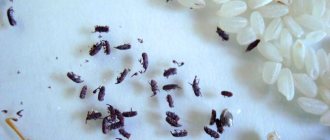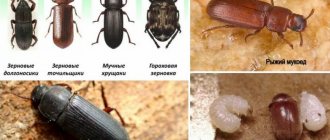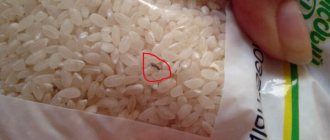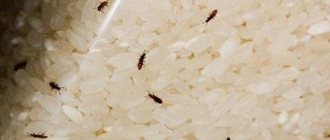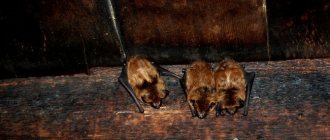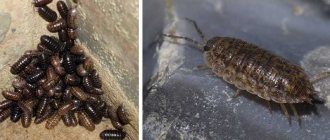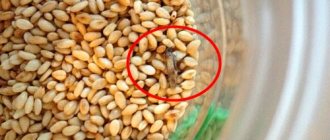Why do bugs appear in cereals, how to get rid of pests and which cereals are most susceptible to their influence? First of all, you need to understand that bugs only appear where there is constant access to food. Insects are attracted to loose materials not only in open containers and bags, but also when scattered on shelves and in cabinets.
Cereals and pasta are a favorite treat not only for bugs, but also for food moths. Insects also actively eat cereals, crackers, dried fruits, bread; they can be found in spices and food concentrates.
What bugs are found in the kitchen and how do they get there?
It’s not enough to discover that there are bugs in flour and cereals, damaging products with lightning speed. To choose effective pest control products, you need to clearly know what type they belong to. There are several main types of bugs that damage bulk products:
- bread grinder;
- flour bug;
- red mucous eater;
- food moth.
Bread grinders are miniature light brown bugs that can fly; they most often settle in cereals; they enjoy baked goods, old medicinal herbs, as well as tea and coffee with great pleasure. They enter the apartment with contaminated store products, as well as animal feed.
Flour bugs settle in flour more often than in any other product; they can often be found in bags of starch. Insects simply penetrate boxes in the kitchen with bulk products, including packages of rye, rice flour, rolled oats and semolina. Infrequently, you can see pests in dried fruits, rice or buckwheat.
The peculiarity of insects is the ability to reproduce quickly. Female beetles camouflage their oviposition in crevices of furniture in the kitchen, in cereals, flour, and on cabinet shelves. A new generation of pests quickly spreads throughout the home in search of food sources.
The red common mucoed is no more than 2.5 mm long. It most often enters the premises together with low-quality animal feed. The pest’s favorite food is cereals, grains, flour with an expired shelf life and a moisture content of no more than 15%. In order for the red flour beetle to stop spoiling food and breeding in the kitchen, it is enough to block access to food sources.
The food moth infests in buckwheat, rolled oats, semolina, rice, flour. A mature individual visually resembles a silver butterfly and reaches a length of 10 cm. Its appearance in the kitchen is associated with violation of food storage rules; in addition, the insect enters the house through ventilation holes and open windows.
In addition to the fact that insects are found in semolina, millet and other cereals, in some cases tea and cocoa, dried fruits, and pasta are also infected.
It is not difficult to identify pests in products - they leave behind a thin web woven from small yellow worms.
Where can I find
Insects live in various foods and love flour and pasta.
Crackers
Bread grinders, which are light brown in color, live in bakeries. Such bugs fly well, hide under the windows in the apartment and gobble up crackers.
Cookie
Tiny insects love straws and are found in drying biscuits. In both a small store and a supermarket you can buy gingerbreads and baked goods, cookies with worms. Such guests appear during long-term storage in the kitchen.
Nuts
Under favorable conditions, food moths begin to multiply. It is not poisonous, but spreads quickly, lays eggs, from which larvae crawl out and adore walnut kernels.
Dried fruits
Compotes rich in vitamins are made from prunes, dried apricots, and apricots. But if the harvesting technology is violated or the storage rules are not followed, dried fruits are attacked by microscopic moth caterpillars.
Food Ingredients
The products contain carbohydrates, fats, proteins, which are necessary for the normal functioning of the body. Insects look for food in different food components.
Bread
Not all mini-bakeries follow the technology for baking loaves and other products. And if the norms are violated, bugs crawl from contaminated flour into damp bread.
Beans
In legumes, weevils appear not only due to improper storage; the parasites attack the plants even in the garden before harvesting. If at least one bug is detected in the beans, they are sent to the freezer or hot oven.
Tea coffee
You can bring grinders from the store into closed cabinets where spices and grains are stored, but moths love not only dried fruits. Insects are not averse to eating tea, cocoa, and coffee beans.
Flour
Bugs that get into the kitchen begin to feed on bulk products and spices. At mills, flour is obtained from wheat, rye, and corn, which is packaged in bags and packages and delivered to stores or warehouses. You can buy such a product already with bugs.
Vegetables
In recent years, a lot of pests have appeared in the fields. To cope with insects, crops have to be sprayed. But if cucumbers, cabbage or tomatoes are stored in improper conditions, they begin to rot and worms and beetles appear.
Furniture
Grinders take up residence in old sofas, chairs, and wooden floors. Insect larvae feed on wood, making passages in it.
Appliances
Cockroaches take up residence in a microwave oven, an electric meat grinder, a gas stove, and even in a refrigerator, and they are not easy to get rid of.
Insects grow and reproduce quickly, but you need to fight them in your apartment carefully so as not to harm your household
Preventive measures: how to prevent infection?
To prevent insects in cereals from complicating your life by requiring a number of operations to destroy them, you can follow simple recommendations regarding the prevention of their appearance. These include:
- Warm up the purchased cereals in the oven at low temperature for half an hour.
- Freezing bulk products in the freezer for 24 hours (use dry, ventilated packaging).
- Dried fruits are treated with boiling water, followed by washing and storing exclusively in the refrigerator.
- Thorough inspection of purchased products (including vacuum packaging) with disposal of cereals and flour with signs of contamination.
Bulk materials should be stored in perforated polyethylene or closed glass containers. As an alternative, metal boxes and ecological bags made of natural linen are suitable.
One of the reasons why bugs appear in flour and cereals is failure to comply with the shelf life of products. To avoid creating conditions favorable for pests, it is worth buying cereals and other bulk products, as well as dried fruits, coffee and tea with a minimum supply.
It is believed that rice, semolina, flour and buckwheat can be stored for no more than six months; oatmeal and millet can be stored for no more than 4 months due to their high fat content.
The record holder for shelf life is polished rice. Many varieties become even better after several years of storage, acquiring additional taste.
If you still cannot avoid contamination of food in the kitchen, you can get rid of bugs in cereals, flour and spices in several ways.
Causes of insects
Where do insects come from in kitchen cabinets? Little lovers of cereals and flour live only in these products. They have nothing to eat outside, so it is impossible to bring beetles from there. They won’t fly into the window or crawl away from their neighbors because they don’t travel long distances. The only reason why bugs appear in cereals is poor quality processing by the manufacturer.
If the manufacturer of bulk products neglects the standards for the production and storage of cereals, poorly processes the goods before packaging, insect larvae end up in stores, and from there - in kitchen cabinets. Most often, insects can be found in cereals sold by weight, but sometimes they are also found in hermetically sealed packages.
As soon as even one package of contaminated product appears in the kitchen, an insect invasion soon occurs. From the larvae present in the cereal, bugs hatch, which quickly spread and multiply.
Recycling is a simple and reliable method
When there is neither the desire nor the ability to fight the increasing population of harmful insects in bulk products in the kitchen, it is worth moving on to a radical method - recycling damaged cereals.
Packages, sacks, containers with bugs are carefully packed in sealed cellophane and taken out of the house.
Places where contaminated products were stored (shelves, cabinets, mezzanines) are thoroughly treated with soda, vinegar or chlorine solution, followed by rinsing with clean water.
Prevention measures
Have you ever had to deal with flour beetles?
It happened, it didn't happen
So, we managed to get rid of the flour beetle. But no one guarantees that the parasite will not appear again. How to avoid this? The first step is to try to seal all the cracks through which the insect can get into the room from the street. The easiest way to do this is to fill them with polyurethane foam. However, you can use other methods (for example, plug it with glass wool or tow).
All supplies should be stored in tightly closed containers. It is better if these are plastic or tin cans - the beetle imago easily gnaws through cellophane and fabric bags. If there is no such container, the products must be placed in a tightly closed cabinet or cupboard.
Store-bought products must be checked before being placed on the shelf. It is possible that they may contain pest larvae.
The next step is to place objects that repel it in places that are attractive to the parasite. Here are a few of them.
Steel
The beetle cannot tolerate the smell of iron oxide. Therefore, in order to scare him away, a steel object is placed in a container with flour or cereal.
Garlic
The flour beetle does not like the smell of garlic. Its slices can be placed among supplies.
Vinegar
When washing kitchen cabinets, you should dilute the water with acetic acid. 1 - 2 tablespoons of a 7 percent solution per 2 - 3 liters of liquid will be enough. You need to wipe the areas that the beetle might like with vinegar once every 1.5 – 2 weeks.
Lavender
This plant successfully repels not only clothes moths, but also flour beetles. A bag of dry grass is placed among the food. You can also regularly lubricate containers with lavender essential oil. Just a couple of drops is enough.
Thermal fighting - what effect does it give?
If there are bugs in the cereal, you can try to remove them by raising the temperature to +50 degrees Celsius. We are talking about treating containers with pests with boiling water or steam. The method is especially effective for removing pests in hard-to-reach places.
To free cereals and other bulk products from insects, you can dry them in the oven at temperatures up to 70 degrees for half an hour, or achieve the result by placing contaminated products in the freezer. Most bugs die at a temperature of -15 degrees Celsius.
After destroying the larvae and bugs from the kitchen cabinets and shelves, it is important not to forget to treat the surfaces, as well as all existing cereals, nuts, and beans. As a result of this treatment, it will be possible to get rid of the remaining insects that will simply float to the surface. However, given that products contaminated with insects are unfit for consumption, it is easier to get rid of them by replenishing supplies with fresh cereals and flour.
How to get rid of bugs forever
You won't be able to get rid of bugs forever. Every time you return from the store with another bag of cereal or flour, with a new freshly baked loaf, you risk bringing insects into your house.
You can only prevent their occurrence as much as possible by following simple recommendations. And reduce the risk of contamination of all products in the kitchen, as well as the proliferation and prosperity of uninvited guests.
There is no 100% way to protect yourself from bringing contaminated grains into your kitchen. The risk is somewhat reduced by the fact that the goods are packaged in sealed bags; such bugs can get into them mainly at the stage of manufacturing and packaging of the goods.
Every time you return from the store with another bag of cereal or flour, with a new freshly baked loaf, you risk bringing insects into your home
Chemicals in pest control
If there are bugs in the cereal, what should you do when the previous methods above do not give the desired effect? In such cases, it makes sense to use chemicals. The active drugs are Karbafos and Antizhuk. The second has a universal effect, helping to cope not only with kitchen bugs, but also with wood bugs that damage furniture, windows, laminate and parquet. The drug must be used with extreme caution, following the instructions.
Another remedy against pests, Rogneda, is a powerful antiseptic that allows you to dispose of a number of domestic insects, including mucous beetles, weevils, cockroaches and ants.
You can also remove bugs from the kitchen using the drug “Lovin Fire Protection”, which allows you to achieve a quick effect. The product has a high level of toxicity and is used when there are no animals or children at home.
Working folk methods: which ones to choose?
Those who consider chemicals too dangerous and the disposal and destruction of insects by lowering or raising temperatures are not so effective should try to solve the problem with the help of folk remedies. Recipes for some of them are below:
- Table vinegar. All surfaces infected with the bug are treated with a vinegar-based water solution, along with the simultaneous disposal of cereals and flour damaged by pests.
- Bay leaf, pepper, garlic, sulfur. All of these are products whose smell is feared not only by flour bugs (the photo below will prevent you from making mistakes in identifying pests), but by other types of insects.
- Antiseptics of natural origin - chamomile or calendula can also repel pests.
An interesting option that allows you to forget, if not forever, then for a long time, what bugs in cereals are (a photo will help you correctly identify the type of each) is a trap based on boric acid.
Bait works on a simple principle: insects are attracted to the bait. Hungry bugs try a poisoned treat, become infected with toxins and poison the rest of the colony.
To prepare the bait, boric acid is mixed in a container with powdered sugar, semolina, honey, and syrup. Treats will only attract pests if they are fresh. It is recommended to use traps when children and pets are not at home, placing them in insect habitats.
Why do bugs appear in cereals?
Many people believe that kitchen pests arise only as a result of gross violations of sanitation and hygiene standards. Unfortunately, it is not. Flour bugs can live in your food, even if you regularly do thorough wet cleaning. The main reason for the appearance of parasites is non-compliance with control standards at food production enterprises. Some manufacturers ignore even such a mandatory procedure as heat treatment, not to mention high storage standards.
You can detect black bugs in cereals even if you purchased the product in vacuum packaging. Insects usually have plenty of time to “invade” while the product is awaiting packaging. Bugs in the kitchen do not limit their stay to one “house”. They quickly and willingly master new nutrient environments, while not forgetting about future generations. Parasites reproduce very quickly and fruitfully. The answer to the question of how to get rid of insects in cereals and in the cupboard will be incomplete if it does not contain information on how to find and destroy egg-laying insects. And they can be located almost anywhere, including the most inconspicuous crevices in furniture. Fortunately, this problem can usually be dealt with without the help of strong chemicals.
